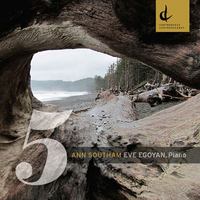
Q2 Music Album of the Week
Ann Southam’s Beautiful and Unsettling Subtleties
Monday, May 20, 2013
By Chloe Veltman
Q2: Living Music. Living Composers.
The music of Ann Southam is a bit like the drawings of Leonardo Da Vinci: Just as the Italian Renaissance master never seemed to tire of sketching a particular object, like a human hand or churning water, over and over again, so the late Canadian composer frequently continued to explore a single fragment of musical material in seemingly countless guises.
As such, the five haunting piano solos by Southam that constitute “5,” a new recording released by the Canadian Music Center, are probably better thought of as the five connected movements of a single large-scale work rather than a handful of distinct compositions.
Upon first listen, there’s not much that distinguishes the pieces, which were discovered in Southam’s house following the composer’s death in 2010, from each other. They are all meandering in tempo, brooding in mood and basically consonant in tonality. A foreboding thread of dissonance runs throughout each track.
But upon closer inspection, the movements reveal distinctive qualities, following on from one another like the way shadows change as the sun crosses the sky, or tides move in and out from the shore.
Pianist Eve Egoyan masterfully manages to retain the overall consistency of style across the five pieces composed from a 12-tone row while drawing our attention to the subtle changes that disrupt the ever-steady pulse of the left hand drone and right hand chords.
Harmonies become lush and expansive at one point, only to shrink to a single basic chord later on. Pauses appear in the texture breaking up the flow of the musical line, and then mysteriously recede. A definitive major cadence contrasts with the ambiguity of an unresolved chord. All of these barely perceptible shifts work together to create a musical experience that is at once beautiful and unsettling.
CHLOE VELTMAN
San Francisco-based arts journalist and broadcaster Chloe Veltman has contributed articles and reviews to The New York Times, BBC Classical Music Magazine, Gramophone, the Los Angeles Times, The Economist, The Wall Street Journal and many other media outlets. She is the host and executive producer of VoiceBox, a weekly, syndicated public radio and podcast series about the human voice, and blogs at ArtsJournal.com. Follow Chloe on Twitter at @chloeveltman.

